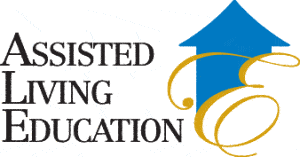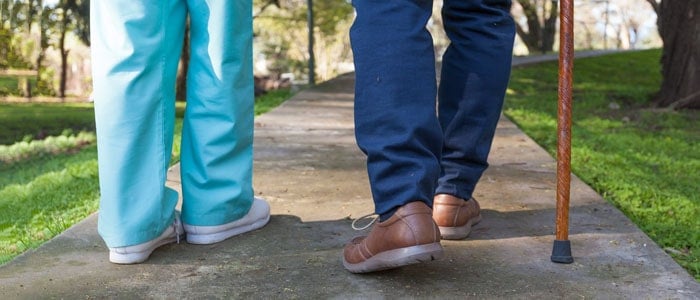FOOT CARE & ISSUES FOR SENIOR RESIDENTS
Despite many of us relying on our feet to get around, it is often one of the more neglected areas of body care. Unless an acute problem arises, we tend to ignore or push through minor aches and pains that may develop as we age. However, years of these minor inconveniences can turn into big problems. Some of these you may encounter with your assisted living residents, whether or not they are ambulatory.
Assisted Living Education (ALE) discusses common causes and problems of foot issues experienced in elderly residents.
Common Problems in Elderly Feet
Aches & Pains – Our bodies naturally incur more wear and tear as we age, especially if we’ve been active in our youth. Our cushy, youthful soles wear thin as fat and collagen begin to degenerate in the body. This is why we start noticing more aches and pains as we hit middle age.
Arthritis – Osteoarthritis (OA) and rheumatoid arthritis (RA) are common diagnoses in elderly residents and can make mobility difficult with painful joints. This could ultimately impact their mental health and well-being as they may withdraw from activities and exercise to avoid the pain.
Bunions, Corns, Spurs, Hammertoes – Most of these are caused by poor-fitting or non-supportive shoes and can become painful. The next section discusses the importance of a well-fitting shoe.
Secondary Conditions – Some individuals develop other problems due to the body compensating for the initial ailment. Hip and knee problems are common secondary issues to walking on painful feet. Our natural reaction to walking on aching feet is to shift our weight/load to give relief to the sore spot. However, this throws your natural bone and joint alignment off, especially over long periods of time.
Ill-Fitting Shoes
Residents who have a long history of wearing heels or other shoes that were ill-fitting are likely to have foot problems in their senior years. Make sure their current pair of shoes are comfortable, the correct size, and provide proper support if necessary. Even if the resident does not walk around much or is not ambulatory, it is still important that whatever they wear is best suited for their body. A poor-fitting or too-tight shoe on a non-ambulatory person will still cause irritation and problems down the line, especially if blood flow is already reduced to the extremities.
Additionally, ill-fitting shoes can increase the risk of falls in the elderly. Though there are a lot of things to consider in shoes for the elderly, finding that Goldilocks or Cinderella fit (i.e., “just right”) is essential for their foot health.
Be careful of:
- Too flexible or worn-out shoes: These shoes will not provide enough support or stability
- Too tall shoes: Extra height can cause instability and increase the chances of a fall
- Heavy shoes: Extra weight or bulk can be cumbersome and also increase the chance of a fall or injury.
- Worn tread or heavy tread: No tread can increase the chance of slipping, while too much tread can catch on a surface and cause an individual to trip.
Podiatrist or Pedicurist?
Because elderly foot health can be compromised in a variety of ways, it’s best to consult with a podiatrist or even the attending physician first before a regular visit to the nail salon.
While the exfoliation and foot soaks at regular nail salons are very relaxing for most of us, it could exacerbate health conditions for elderly residents. Elderly skin is not as resilient as it once was, and the scrubbing could be too abrasive. Additionally, individuals with diabetes, circulatory issues, or other conditions that weaken the immune system could be susceptible to infections if they happen to visit a salon that is less meticulous with the cleaning of their facility, tools, or equipment.
A podiatrist can properly care for ingrown toenails, excess nail growths, and are and skilled in caring for individuals on blood-thinners.
Tips for Healthy Foot Maintenance
There are some basic, everyday things you can do as you visit your residents that will help in overall foot and general healthcare. Even if you are not involved in the direct care of the resident, your observations and rapport can help in detecting problems that the resident may neglect or not know how to express.
Take Note of New Developments
Notice your resident stepping more gingerly or favoring one side? Make note of this and similar observations and bring it to the attention of the attending physician. Even if it seems inconsequential or the resident tries to brush it off, detecting any physical or behavioral change at its earliest can help tremendously in preventing bigger problems down the line.
Basic Foot Care
Those involved with the daily care of the residents should keep an eye on nail lengths for both fingers and toes. Keeping toenails regularly trimmed can help with ingrown nail problems, as well as prevent any pain, irritation, or further problems due to impeding a proper shoe fit. Make sure the resident’s skin and feet are well-moisturized to prevent dryness or cracking which, if left untreated, can lead to discomfort and greater potential for infection.
Keep Warm
Thick socks or bedtime socks are good for the cooler months of the year. Many residents suffer poor circulatory problems due to diabetes or other conditions. Ensuring they are warm encourages blood vessel dilation and helps with oxygen & nutrient flow to the extremities.
Caveats:
- Make sure the resident is warm and comfortable, but not overheating. Overheating can cause a different array of problems.
- Be sure to check whether their shoes can accommodate thicker socks; cramping their foot will defeat the purpose.
If your residents have friends or family who regularly visit, help keep them educated and informed of what they can do to help. Be sure to consult with your supervisor first to ensure HIPAA compliance.
_____________
Assisted Living Education is committed to offering the best quality training and services for serving the elderly community. Our classroom and online courses provide invaluable education and skills from instructors with extensive of field experience. Explore our courses on RCFE certification, continuing education, and more! Visit our contact page to reach us directly.



